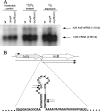Thioredoxin reductase is essential for thiol/disulfide redox control and oxidative stress survival of the anaerobe Bacteroides fragilis
- PMID: 17873045
- PMCID: PMC2168685
- DOI: 10.1128/JB.00714-07
Thioredoxin reductase is essential for thiol/disulfide redox control and oxidative stress survival of the anaerobe Bacteroides fragilis
Abstract
Results of this study showed that the anaerobic, opportunistic pathogen Bacteroides fragilis lacks the glutathione/glutaredoxin redox system and possesses an extensive number of putative thioredoxin (Trx) orthologs. Analysis of the genome sequence revealed six Trx orthologs and an absence of genes required for synthesis of glutathione and glutaredoxins. In addition, it was shown that the thioredoxin reductase (TrxB)/Trx system is the major or sole redox system for thiol/disulfide cellular homeostasis in this anaerobic bacterium. Expression of the B. fragilis trxB gene was induced following treatment with diamide or H(2)O(2) or exposure to oxygen. This inducible trxB expression was OxyR independent. Northern blot hybridization analysis showed that the trxB mRNA was cotranscribed with lolA as a bicistronic transcript or was present as a monocistronic transcript that was also highly induced under the same conditions. The role of LolA, a prokaryotic periplasmic lipoprotein-specific molecular chaperone in the thiol/disulfide redox system, is unknown. A trxB deletion mutant was more sensitive to the effects of diamide and oxygen than the parent strain. In addition, the trxB mutant was unable to grow in culture media without addition of a reductant. Furthermore, the trxB mutant was not able to induce intraabdominal abscess formation in a mouse model, whereas the parent strain was. Taken together, these data strongly suggest that TrxB/Trx is the major, if not the sole, thiol/disulfide redox system in this anaerobe required for survival and abscess formation in a peritoneal cavity infection model.
Figures







Similar articles
-
The redox-sensitive transcriptional activator OxyR regulates the peroxide response regulon in the obligate anaerobe Bacteroides fragilis.J Bacteriol. 2000 Sep;182(18):5059-69. doi: 10.1128/JB.182.18.5059-5069.2000. J Bacteriol. 2000. PMID: 10960088 Free PMC article.
-
Roles of thioredoxin and thioredoxin reductase in the resistance to oxidative stress in Lactobacillus casei.Microbiology (Reading). 2012 Apr;158(Pt 4):953-962. doi: 10.1099/mic.0.053942-0. Epub 2012 Feb 2. Microbiology (Reading). 2012. PMID: 22301908
-
Thioredoxins in redox maintenance and survival during oxidative stress of Bacteroides fragilis.J Bacteriol. 2009 May;191(10):3384-91. doi: 10.1128/JB.01665-08. Epub 2009 Mar 13. J Bacteriol. 2009. PMID: 19286811 Free PMC article.
-
The thioredoxin antioxidant system.Free Radic Biol Med. 2014 Jan;66:75-87. doi: 10.1016/j.freeradbiomed.2013.07.036. Epub 2013 Jul 27. Free Radic Biol Med. 2014. PMID: 23899494 Review.
-
Conferring specificity in redox pathways by enzymatic thiol/disulfide exchange reactions.Free Radic Res. 2016;50(2):206-45. doi: 10.3109/10715762.2015.1120864. Free Radic Res. 2016. PMID: 26573728 Review.
Cited by
-
Ferritin-like family proteins in the anaerobe Bacteroides fragilis: when an oxygen storm is coming, take your iron to the shelter.Biometals. 2013 Aug;26(4):577-91. doi: 10.1007/s10534-013-9650-2. Epub 2013 Jul 11. Biometals. 2013. PMID: 23842847 Free PMC article.
-
Deletion of glutaredoxin promotes oxidative tolerance and intracellular infection in Listeria monocytogenes.Virulence. 2019 Dec;10(1):910-924. doi: 10.1080/21505594.2019.1685640. Virulence. 2019. PMID: 31680614 Free PMC article.
-
Anaerobic utilization of Fe(III)-xenosiderophores among Bacteroides species and the distinct assimilation of Fe(III)-ferrichrome by Bacteroides fragilis within the genus.Microbiologyopen. 2017 Aug;6(4):e00479. doi: 10.1002/mbo3.479. Epub 2017 Apr 11. Microbiologyopen. 2017. PMID: 28397401 Free PMC article.
-
Role of the Porphyromonas gingivalis extracytoplasmic function sigma factor, SigH.Mol Oral Microbiol. 2012 Jun;27(3):202-19. doi: 10.1111/j.2041-1014.2012.00643.x. Epub 2012 Mar 28. Mol Oral Microbiol. 2012. PMID: 22520389 Free PMC article.
-
Modulation of Iron Import and Metronidazole Resistance in Bacteroides fragilis Harboring a nimA Gene.Front Microbiol. 2022 Jun 9;13:898453. doi: 10.3389/fmicb.2022.898453. eCollection 2022. Front Microbiol. 2022. PMID: 35756037 Free PMC article.
References
-
- Andreesen, J. R., M. Wagner, D. Sonntag, M. Kohlstock, C. Harms, T. Gursinsky, J. Jager, T. Parther, U. Kabisch, A. Grantzdorffer, A. Pich, and B. Sohling. 1999. Various functions of selenols and thiols in anaerobic gram-positive, amino acids-utilizing bacteria. Biofactors 10:263-270. - PubMed
-
- Arner, E. S., and A. Holmgren. 2000. Physiological functions of thioredoxins and thioredoxin reductases. Eur. J. Biochem. 267:6102-6109. - PubMed
-
- Baughn, A. D., and M. H. Malamy. 2004. The strict anaerobe Bacteroides fragilis grows in and benefits from nanomolar concentrations of oxygen. Nature 427:441-444. - PubMed
-
- Bayley, D. P., E. R. Rocha, and C. J. Smith. 2000. Analysis of cepA and other Bacteroides fragilis genes reveals a unique promoter structure. FEMS Microbiol. Lett. 193:149-154. - PubMed
Publication types
MeSH terms
Substances
Grants and funding
LinkOut - more resources
Full Text Sources
Other Literature Sources
Molecular Biology Databases

